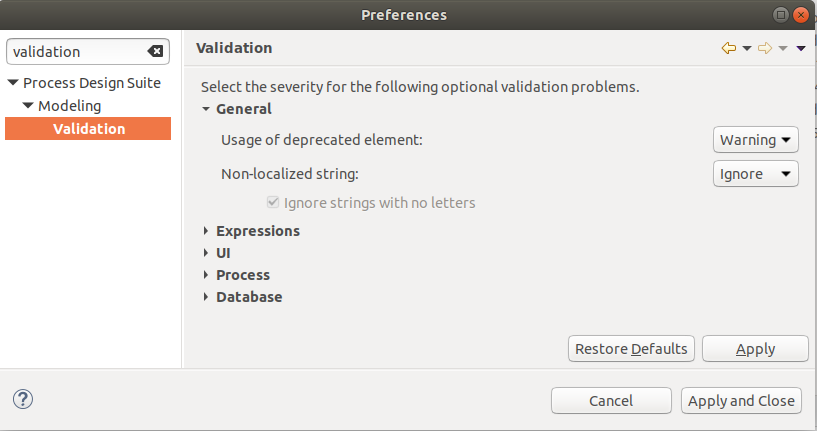
Disambiguation note: This section describes the validation of all model resources in Designer, such as, syntax of expressions, missing module imports, return values for element properties, etc. If this is not the topic you looking for, consider the following:
Validation in Designer checks the language and modeling correctness of the saved workspace data. Note that closed projects, non-executable Processes and contents of non-main Pools are not validated. When it detects a problem, it assigns it severity and renders the problem marker on all visualizations of the element and all its parent modeling elements:
 : severe mistakes that prevent the compilation and deployment
: severe mistakes that prevent the compilation and deployment : issues that may affect execution and cause undesired behavior but are generally harmless; for example, a missing value of a parameter, which is interpreted automatically as null.
: issues that may affect execution and cause undesired behavior but are generally harmless; for example, a missing value of a parameter, which is interpreted automatically as null. are notifications of non-standard situations, which influence neither the validity nor further deployment. Infos occur, for example, if a modeling element is present in the process definition, but does not appear in any Diagram.
are notifications of non-standard situations, which influence neither the validity nor further deployment. Infos occur, for example, if a modeling element is present in the process definition, but does not appear in any Diagram.The severity of a detected problem is generally assigned automatically but in some cases you can define the severity yourself.
Your workspace is by default validated automatically on each save and before module upload. You can trigger validation also manually: right-click the node in the GO-BPMN Explorer and click Validate in the context menu.
If your resource has validation problems even though the expressions are correct, try cleaning the project: on the main menu, go to Project -> Clean
To turn automatic validation off on a particular project, on the main menu, go to Project and unselect Build Automatically.
The detected problems are listed in the Problems view. The type of individual problems displayed in the view may differ, though mostly it has the “GO-BPMN Problem” value; for information about other problem types refer to www.help.eclipse.org or documentation of the respective plug-in.
You can configure the severity of some of the problem that validation checks:

= is used as an equal sign (== is preferred)void is preferred)Database object name length: maximum database name of a column, table, foreign keys, etc.
This setting is primarily intended for Oracle databases, which do not allow names longer than 30 characters.
Imported GO-BPMN Modules created in older versions of Designer may not be validated automatically. To enable validation of older modules, do the following:
Any old GO-BPMN modules in the workspace are added to the validation scope.
To hide problem markers in a diagram editor (markers remain visible in the GO-BPMN Explorer and other views), do the following:
Click Show Diagram Items (  ) button on the main toolbar.
) button on the main toolbar.
The button is available only when a diagram editor is focused.